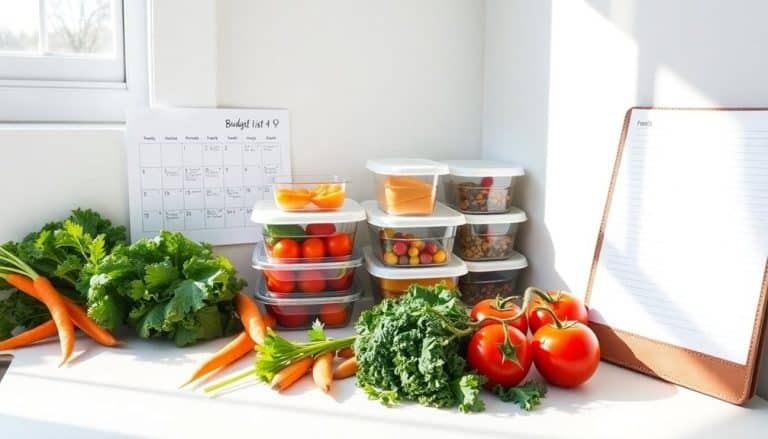This website contains affiliate links. Some products are gifted by the brand to test. As an Amazon Associate, I earn from qualifying purchases. The content on this website was created with the help of AI.
You can efficiently prep 21 nutritious meals in 2 hours while saving $320 monthly compared to takeout or daily cooking. Start by gathering essential equipment: airtight containers, sharp knife, cutting board, and measuring tools. Plan your shopping list around bulk proteins, whole grains, and seasonal produce to maximize savings. Use batch cooking techniques – prepare proteins in 4-6 portion quantities while simultaneously cooking grains and roasting vegetables. Follow proper food safety by storing meals in labeled containers within 2 hours and consuming within 4 days. Master these fundamentals to transform your meal prep routine into a cost-effective, time-saving system.
Key Takeaways
- Plan recipes that share common ingredients and prep methods to maximize efficiency and reduce costs through bulk buying.
- Set up distinct preparation zones with all necessary equipment ready before starting to minimize time waste during cooking.
- Batch cook proteins, grains, and vegetables simultaneously using multiple cooking methods like stovetop, oven, and pressure cooker.
- Use the assembly-line method to portion and package meals quickly, following standard serving sizes for proteins, carbs, and vegetables.
- Label all containers with dates and contents, storing them properly in refrigerator or freezer within two hours of preparation.
Essential Meal Prep Equipment
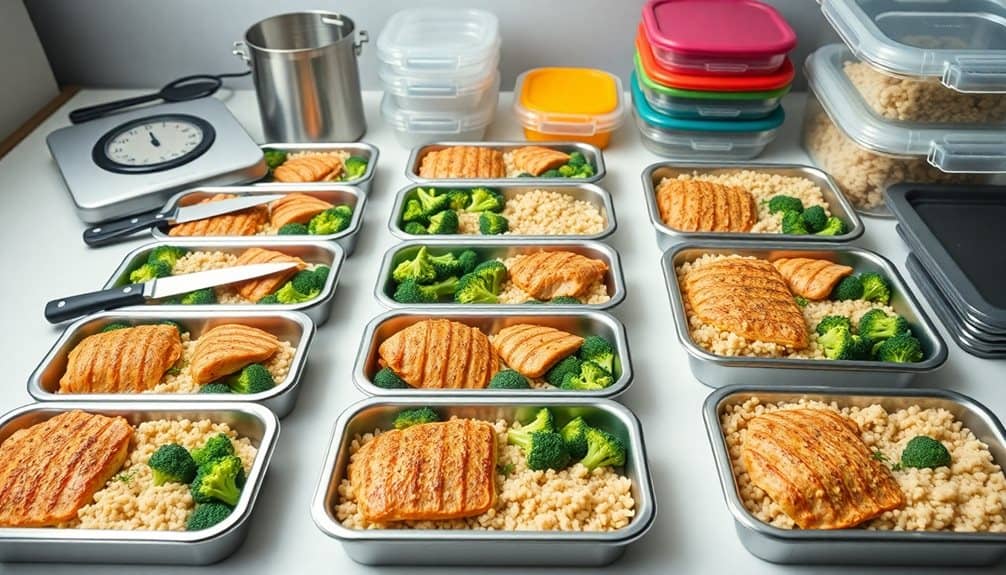
Along with proper planning, having the right equipment is vital for successful meal prepping on a budget. You’ll need several airtight storage containers in various sizes, preferably made from BPA-free plastic or glass, to maintain food freshness and prevent bacterial growth. Research shows proper food storage can extend shelf life by up to five days.
A sharp chef’s knife and cutting board are essential for efficient vegetable and protein preparation. You’ll also need measuring cups and spoons to guarantee accurate portion control and consistent macronutrient ratios. A food scale is particularly important for precise protein measurements and portion management.
For cooking, you’ll require a large stockpot for soups and grains, a sheet pan for roasting vegetables, and at least two medium-sized saucepans. A high-quality non-stick skillet reduces the need for excess cooking oils while assuring even heat distribution. Consider investing in an instant-read thermometer to verify safe cooking temperatures for meats, as the USDA recommends specific internal temperatures to prevent foodborne illness. If budget allows, a slow cooker or pressure cooker can greatly reduce active cooking time while maintaining nutrient retention.
Planning Your Shopping List
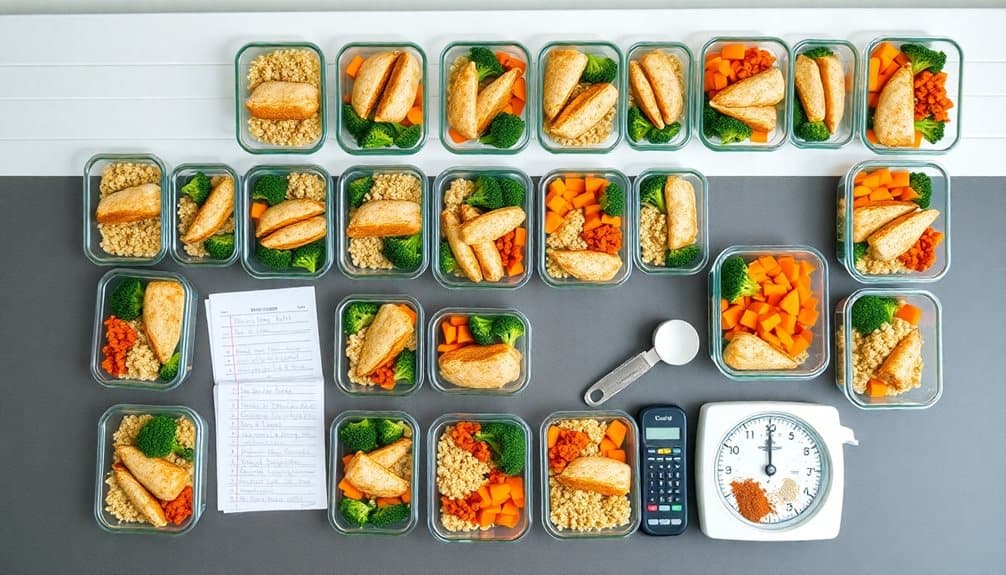
Creating a shopping list requires careful planning to maximize nutritional value while minimizing costs. You’ll need to inventory your pantry first, checking for staples like grains, legumes, and seasonings that you already have. Next, review your planned recipes and cross-reference ingredients to identify overlapping items that you can buy in bulk.
Focus on seasonal produce, which is typically less expensive and more nutrient-dense. You’ll want to prioritize vegetables with longer shelf lives, such as carrots, cabbage, and sweet potatoes. For proteins, consider cost-effective options like whole chickens, eggs, and dried beans, which provide excellent nutritional value per dollar spent.
Don’t forget to check store circulars and compare unit prices before finalizing your list. You’ll save money by organizing your list by department and identifying where bulk purchases make sense. Stock up on shelf-stable items when they’re on sale, but only if you’ll use them within their shelf life. Remember to include versatile ingredients that can work in multiple recipes, such as onions, garlic, and basic herbs, which will help reduce waste and optimize your grocery budget.
Just as distilled water helps prevent mineral buildup in indoor fountains, using purified water when cooking grains and legumes can improve their texture and prevent unwanted mineral deposits in your cookware.
Time-Saving Kitchen Strategies
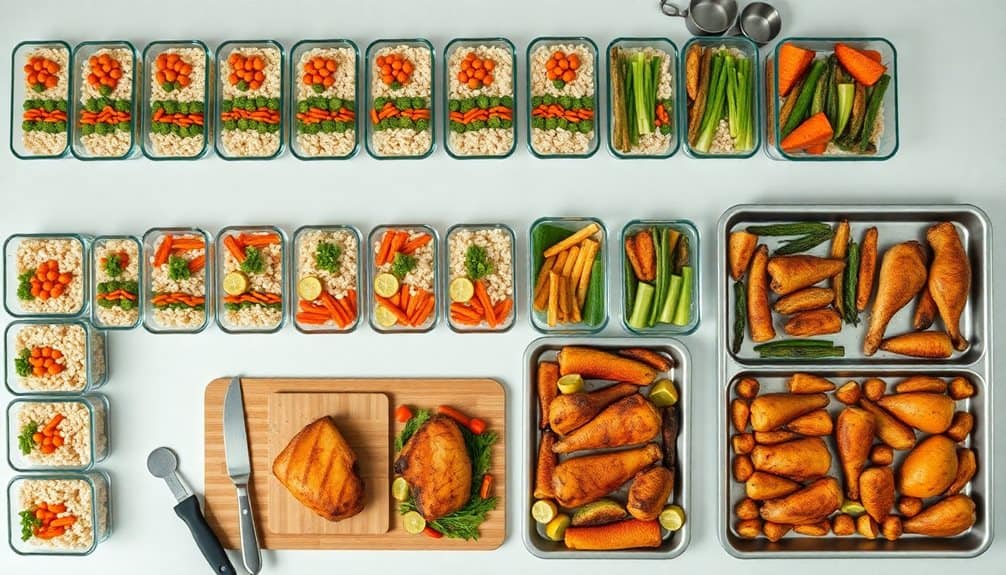
Successful meal prep hinges on efficient kitchen workflows that maximize your productivity. Start by organizing your workspace into distinct zones: a cutting station with sharp knives and cutting boards, a cooking area with pots and pans ready, and a packaging station with containers and labels. This setup minimizes unnecessary movement and reduces cross-contamination risks.
Implement parallel processing techniques to optimize your time. While proteins are cooking, you can chop vegetables or prepare sauces. Utilize multiple cooking methods simultaneously – your oven can roast vegetables while you’re sautéing proteins on the stovetop and steaming rice in a cooker. This approach can reduce total prep time by up to 40%.
Keep frequently used tools within arm’s reach and maintain proper knife skills to increase chopping efficiency. Use time-saving equipment like food processors for bulk vegetable prep or immersion blenders for quick sauces. When cooking multiple portions, always scale up ingredients proportionally and use large-batch cooking methods. Clean as you go to maintain workspace efficiency and guarantee food safety standards. Store prepped ingredients in properly sealed containers at appropriate temperatures to maintain nutritional value and extend shelf life.
Bulk Buying Tips

Smart bulk purchasing forms the foundation of cost-effective meal preparation, but knowing where and how to buy can make a significant difference in your savings. Focus on nutrient-dense staples like whole grains, legumes, and frozen vegetables, which offer extended shelf life and consistent nutritional value.
You’ll maximize your buying power by timing your purchases with store sales cycles, which typically occur every 6-8 weeks. Compare unit prices rather than package prices, and don’t assume warehouse clubs always offer the best deals. Track prices across different retailers using a price book or digital app to identify genuine bargains.
Consider splitting bulk purchases with another household if storage space is limited. Store dry goods in airtight containers at 70°F or below to prevent nutrient degradation and extend shelf life. For frozen items, maintain a constant temperature of 0°F to preserve nutritional content. You’ll want to rotate your stock using the FIFO (first-in, first-out) method to prevent waste.
Purchase seasonal produce in bulk when prices drop, then freeze or preserve excess. Studies show that frozen produce often retains more nutrients than fresh items that have been transported long distances. Just as seed starting equipment helps gardeners save money by growing their own produce, smart bulk buying helps maximize your grocery budget.
Choosing Budget-Friendly Proteins
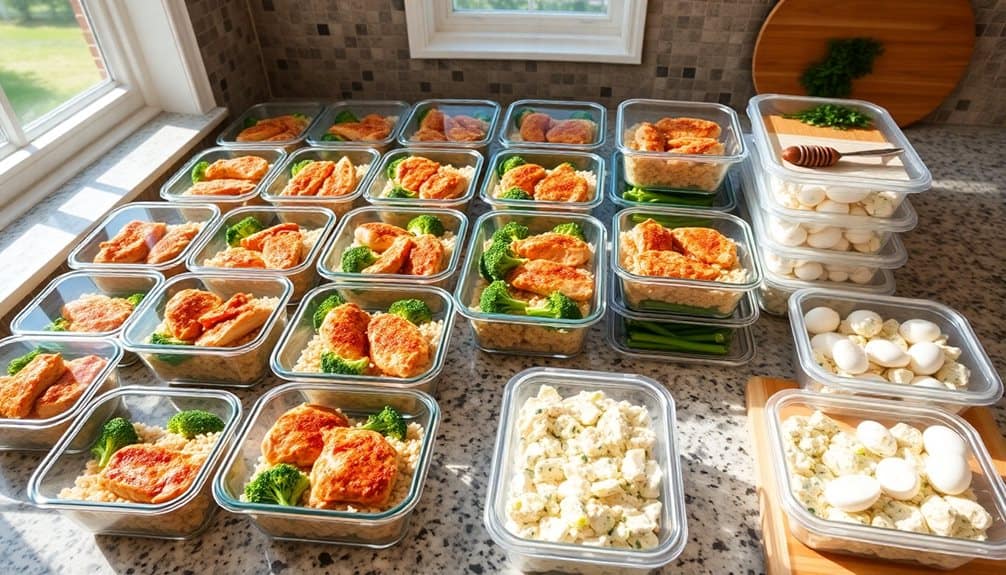
While bulk staples form the foundation of frugal meal prep, protein selection can make or break your food budget. You’ll want to focus on complete proteins that provide all essential amino acids while keeping costs low. Plant-based proteins often cost considerably less per gram than animal proteins, while still meeting your nutritional needs.
Consider these budget-friendly protein sources that offer excellent nutritional value:
- Dried legumes (lentils, beans, chickpeas) at $1-2 per pound, providing 7-9g protein per serving
- Whole eggs at $2-3 per dozen, delivering 6-7g protein each
- Canned tuna and sardines, offering 20-25g protein per serving
- Frozen chicken thighs, typically 30% cheaper than breasts with similar protein content
- Textured vegetable protein (TVP), yielding 12g protein per ounce when rehydrated
When shopping for proteins, you’ll maximize savings by comparing the price per gram of protein rather than price per pound. Buy proteins on sale, portion them immediately, and freeze what you won’t use within 3-4 days. This strategy helps you maintain quality while keeping your protein costs around $2-3 per meal.
Smart Grocery Shopping Hacks
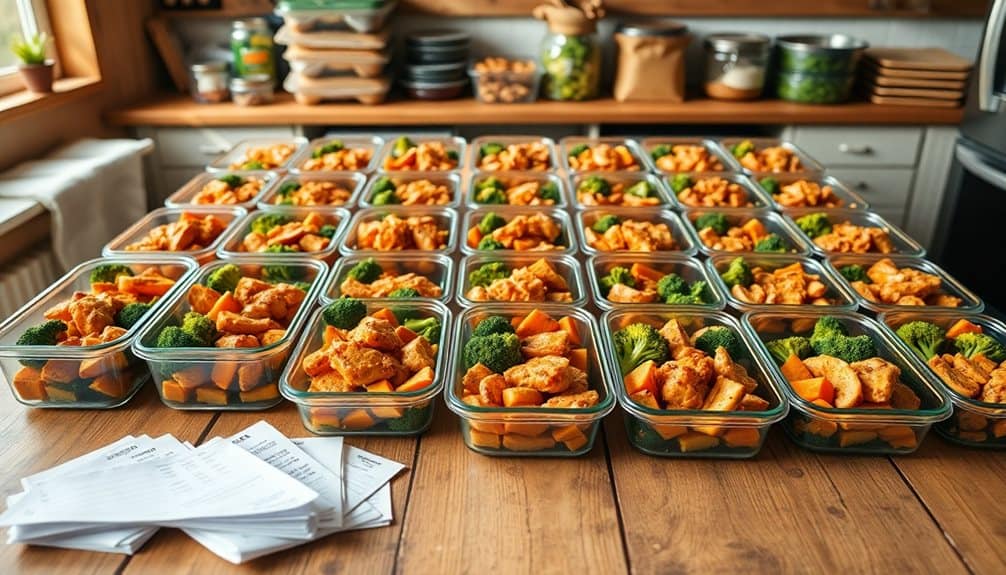
Effective grocery shopping requires strategic planning and insider knowledge to maximize your savings. Start by downloading your store’s mobile app to access digital coupons and weekly sales. Research shows that shoppers who use store apps save an average of 20% more than those who don’t.
Plan your shopping trips during markdown periods, typically early mornings for fresh produce and evenings for perishable items. Shop the store’s perimeter first, where whole foods are located, then selectively visit interior aisles for specific items. Studies indicate that 80% of impulse purchases occur in center aisles.
Compare unit prices rather than package prices, and don’t assume bulk purchases are always cheaper. Buy seasonal produce when it’s most abundant and lowest-priced, then freeze excess for future use. Consider joining loyalty programs that offer personalized discounts based on your shopping patterns. Research by consumer economists shows that loyalty program members save 15-25% more annually.
Stock up on shelf-stable items during sales cycles, which typically occur every 6-8 weeks. Always check clearance sections for deeply discounted items approaching their best-by dates, which are often still perfectly safe to consume. Installing pot and pan organizers in your kitchen cabinets can help you better track your grocery inventory and prevent unnecessary duplicate purchases.
Prep Station Setup
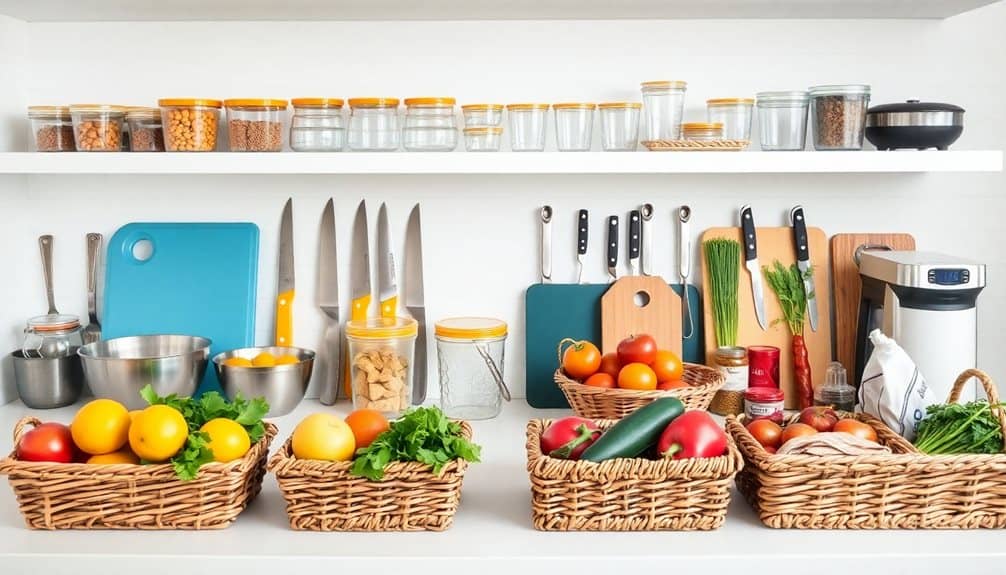
Now that you’ve gathered your groceries strategically, organizing your kitchen workspace can double your meal prep efficiency. Research shows that professional kitchen layouts follow specific patterns to maximize output while minimizing movement, a concept you can apply to your home setup.
Create distinct zones within your kitchen, positioning tools and ingredients based on their sequence of use. Studies indicate that reducing unnecessary movement can save up to 30% of total prep time.
- Set up a central chopping station with your cutting board, knives, and compost bowl for vegetable trimmings
- Position a protein prep area with a separate cutting board, thermometer, and sanitizing solution
- Arrange measuring tools, spices, and small appliances within arm’s reach of your main work surface
- Designate a portion-control station with your food scale and storage containers
- Keep cleaning supplies accessible but separate from food prep areas to prevent cross-contamination
Position your slow cooker, instant pot, or other cooking appliances near electrical outlets, ensuring their steam vents won’t interfere with other prep areas. This systematic approach aligns with food safety protocols while maximizing your workspace’s functionality.
Batch Cooking Basics
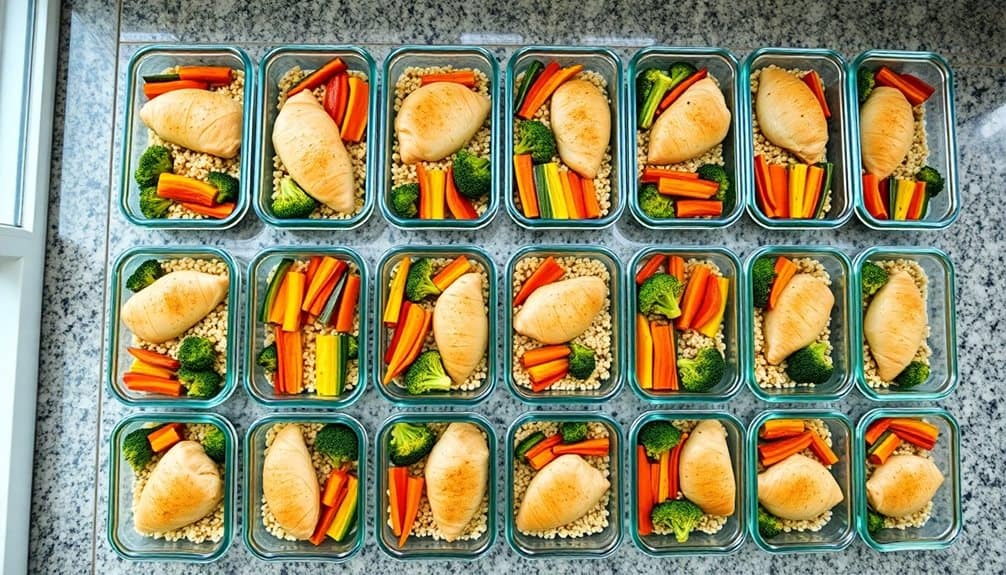
Diving into batch cooking can transform your weekly meal preparation through strategic volume cooking. You’ll maximize efficiency by preparing multiple portions of proteins, grains, and vegetables simultaneously, reducing both cooking time and energy costs. By cooking in batches, you’ll maintain consistent portion control while minimizing food waste.
Start with proteins like chicken breasts, lean ground turkey, or legumes, which you can cook in 4-6 portion quantities. While your proteins cook, prepare whole grains such as brown rice or quinoa in a separate pot – these offer complex carbohydrates and essential fiber. Steam or roast vegetables in large batches to retain maximum nutritional value, particularly water-soluble vitamins.
Consider nutrient retention when planning your batch cooking sequence. You’ll want to slightly undercook vegetables that you’ll reheat later, preventing nutrient loss and maintaining texture. Store your prepped components in airtight containers, keeping proteins, grains, and vegetables separate to maintain food safety standards and extend shelf life. Label each container with the preparation date and consume within 3-4 days for ideal freshness and nutritional value. Similar to organizing beehive stand spacing, maintain proper distance between stored food containers to ensure adequate airflow and prevent cross-contamination.
Storage Container Guide
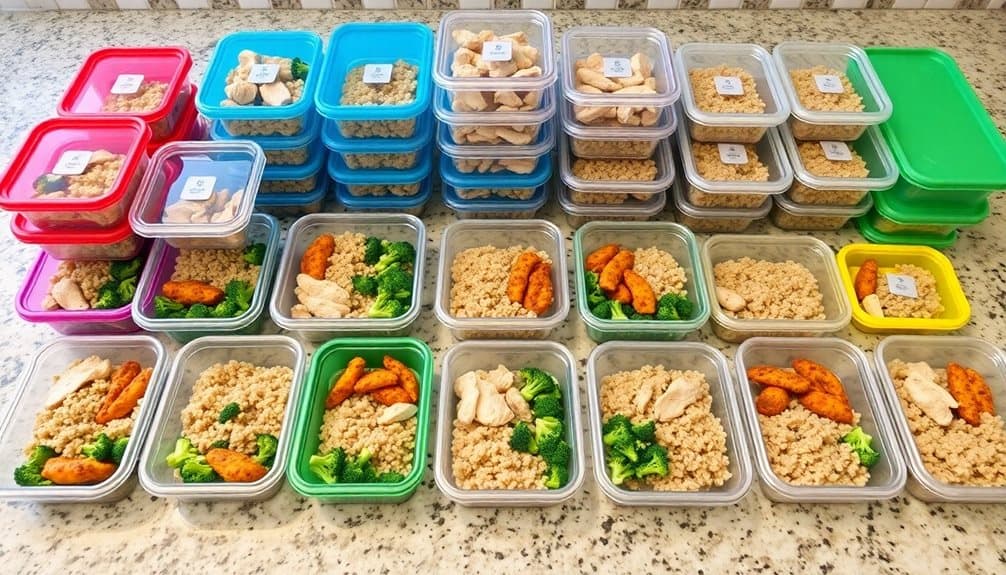
Proper storage containers serve as the foundation of successful meal preparation, protecting both your food investment and nutritional content. You’ll need a variety of container sizes and types to accommodate different meal components while ensuring ideal freshness and preventing cross-contamination.
Select containers that meet these essential criteria:
- BPA-free plastic or glass construction with airtight, leak-proof seals
- Microwave-safe materials that won’t warp or leach chemicals when heated
- Stackable designs for efficient refrigerator and freezer organization
- Clear or transparent sides for easy meal identification
- Dishwasher-safe components for thorough sanitization
For hot foods, use tempered glass containers that resist thermal shock and maintain temperature stability. When storing leafy greens and fresh produce, opt for containers with ventilation systems to regulate moisture and prevent premature wilting. Choose portion-sized containers for individual servings, which helps control caloric intake and simplifies grab-and-go meals. Consider investing in vacuum-sealed containers for items you’ll freeze, as they prevent freezer burn and extend storage life up to 50% longer than standard containers.
Freezer Organization Methods

With your storage containers ready, a well-organized freezer becomes your next meal prep advantage. Ideal freezer organization maximizes space efficiency while preventing freezer burn and maintaining nutritional value. You’ll want to designate specific zones: ready-to-eat meals at eye level, raw proteins at the bottom, and vegetables in the middle section.
Label each container with the meal name, date prepared, and reheating instructions using freezer-safe tape or permanent marker. Stack similar items together, and use clear bins to create compartments that prevent items from getting lost in the back. You’ll need to maintain a temperature of 0°F (-18°C) or below to preserve food quality and prevent bacterial growth.
Implement the FIFO (First In, First Out) method by placing newer items behind older ones. Keep a freezer inventory list on your phone or the freezer door to track what you have. Don’t overfill containers – leave about 1/2 inch of headspace for liquids to expand during freezing. Position containers upright until completely frozen to prevent leakage, then stack horizontally to maximize space. This systematic approach guarantees your meal prep stays organized and nutritionally intact for up to three months.
Weekly Meal Calendar
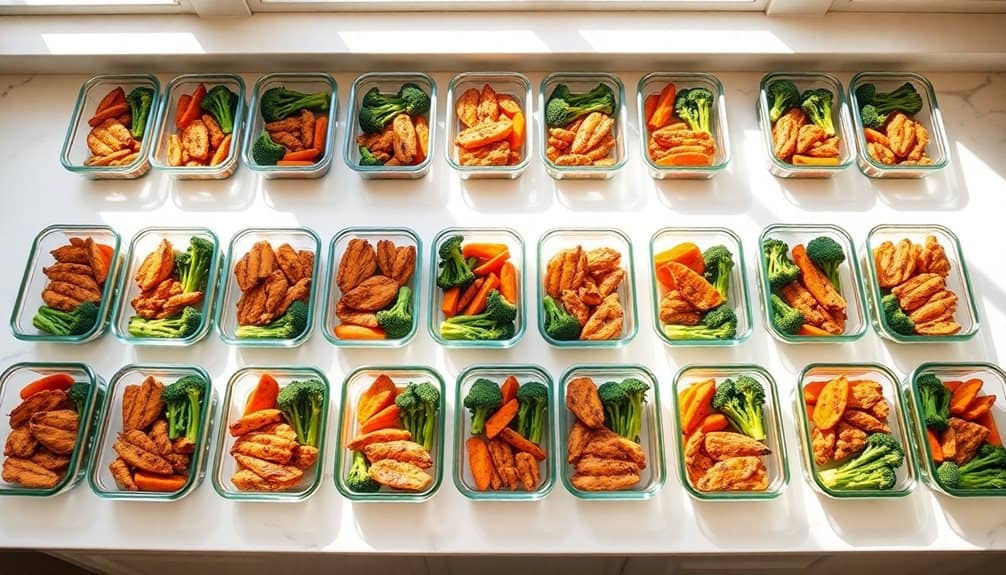
A well-structured meal calendar serves as the foundation for successful budget meal prep. When you plan your meals systematically, you’ll reduce food waste, optimize ingredient usage, and maintain better portion control. Research shows that meal planning can reduce grocery expenses by up to 25% while improving nutritional balance.
Start by mapping out your week with these essential components:
- Assign protein sources to specific days, rotating between lean meats, fish, legumes, and plant-based options
- Schedule ingredient crossover days to maximize bulk purchases and reduce waste
- Designate prep-heavy meals for days when you have more time
- Plan strategic leftover nights to accommodate busy schedules
- Include flexible spots for using seasonal sale items or pantry ingredients
Consider your household’s nutritional needs when structuring your calendar. You’ll want to guarantee balanced macronutrient distribution throughout the week while incorporating diverse micronutrient sources. Studies indicate that successful meal preppers typically spend 30-45 minutes planning their weekly calendar, resulting in consistently better dietary choices and reduced impulse food purchases.
Use your calendar as a living document, adjusting it based on your family’s preferences, schedule changes, and seasonal food availability. Like a greenhouse ventilation system, proper meal planning requires regular monitoring and adjustment to maintain optimal conditions for success.
Portion Control Guidelines
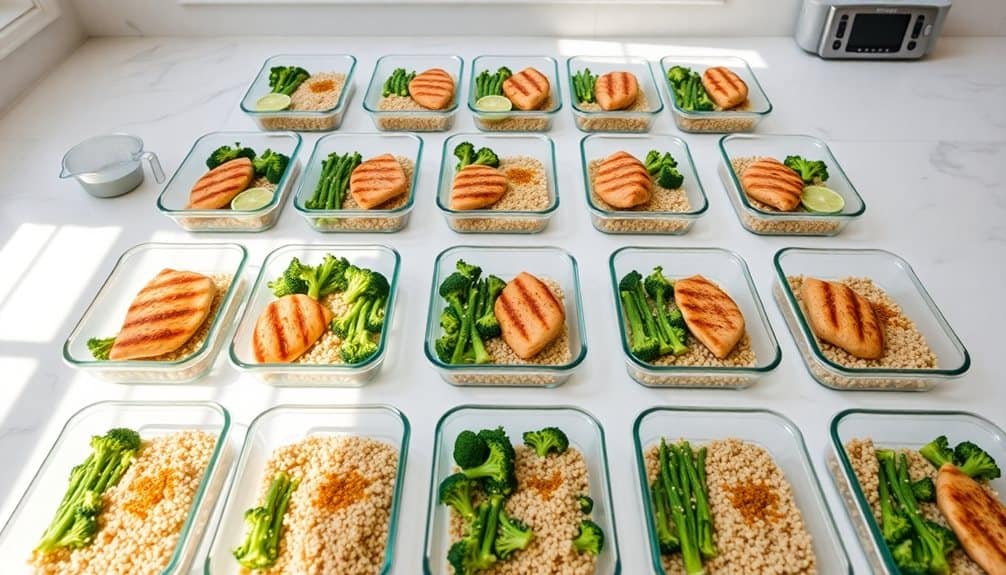
Mastering portion control directly impacts the success of your meal prep strategy and budget. To properly portion your meals, you’ll need to understand standard serving sizes and your individual caloric needs. Use a kitchen scale to measure proteins (5-6 oz), complex carbohydrates (½-1 cup), and vegetables (1-2 cups) for each meal container.
For protein-rich foods, aim for palm-sized portions (about 20-30g protein) at each meal. You’ll want to measure starches like rice, quinoa, or potatoes using measuring cups – typically ½ cup for women and 1 cup for men. Fill the remaining container space with non-starchy vegetables, which provide essential nutrients while keeping calories low.
When portioning fats, limit them to thumb-sized amounts (1-2 tablespoons). This includes oils, nuts, seeds, or avocado. If you’re using meal prep containers, choose ones with built-in compartments that align with the USDA’s MyPlate guidelines: ¼ protein, ¼ starches, and ½ vegetables. Remember that your specific portions may need adjustment based on your height, weight, activity level, and fitness goals.
Food Safety Essentials

Safe food handling forms the cornerstone of successful meal preparation. When you’re batch cooking multiple meals, it’s critical to maintain proper temperature control and prevent cross-contamination. Always wash your hands thoroughly before handling food and between working with different ingredients, especially raw meats and produce.
Temperature management is crucial for food safety during meal prep. Keep cold foods below 40°F and make sure hot foods reach 165°F. Don’t leave perishable items at room temperature for more than two hours, and cool prepared foods quickly before refrigerating.
- Use separate cutting boards and utensils for raw meats and other ingredients
- Store prepped meals in airtight containers within two hours of cooking
- Label containers with contents and preparation date
- Refrigerate meals that will be eaten within 3-4 days
- Freeze meals that won’t be consumed within the safe refrigeration window
Remember to clean and sanitize all work surfaces before and after meal prep. When reheating prepared meals, ensure they reach 165°F throughout to kill any potential bacteria. If you’re unsure about a meal’s safety, follow the “when in doubt, throw it out” rule.
Cost Per Meal Breakdown
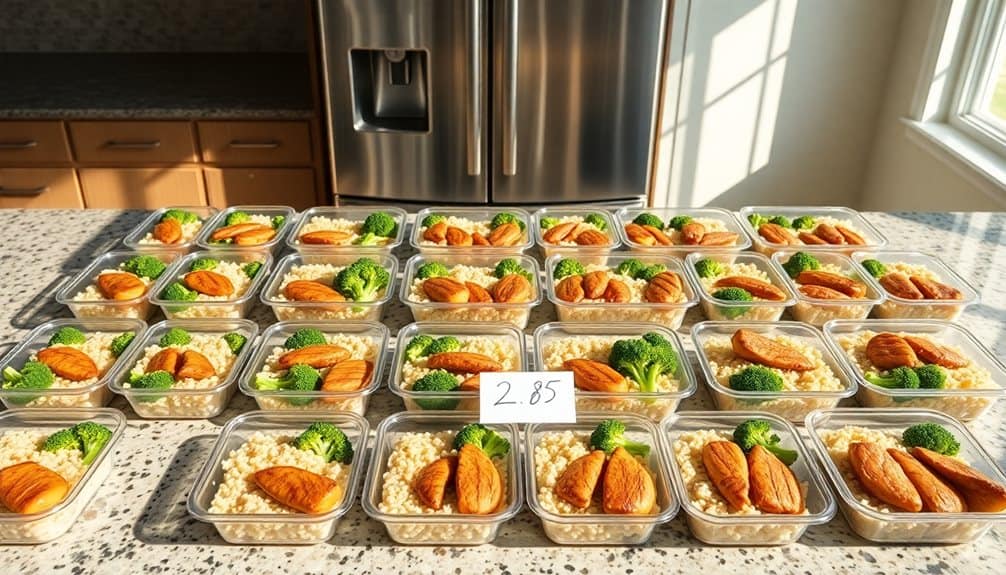
Understanding your cost per meal helps enhance your food budget and meal planning strategy. By tracking expenses and dividing the total cost by the number of portions, you’ll determine your precise cost per serving. For a 21-meal prep plan, you’ll want to calculate both individual meal costs and the weekly average.
Your protein sources typically account for 40-50% of meal costs, with chicken breast averaging $2.50 per serving, lean beef at $3.50, and fish at $4.00. Complex carbohydrates like rice, pasta, and potatoes contribute 15-20% of costs, usually $0.30-0.50 per serving. Fresh vegetables and fruits make up 20-25% of expenses, averaging $1.00-1.50 per serving. Seasonings, oils, and additional ingredients account for the remaining 10-15%.
When buying in bulk and preparing meals at home, you can achieve an average cost of $3.50-4.50 per meal, considerably lower than restaurant alternatives. To reduce costs further, you can substitute cheaper protein sources like legumes ($0.50 per serving) and eggs ($0.25 per egg), or buy seasonal produce. Track your spending using a spreadsheet or meal planning app for enhanced cost control.
Ingredient Substitutions

With budget-conscious meal prep, smart ingredient substitutions can greatly reduce costs while maintaining nutritional value. You’ll find that many expensive ingredients have affordable alternatives that provide similar nutrients and culinary functions. When planning your meals, consider seasonal produce availability and local market prices to maximize savings.
- Replace quinoa with brown rice to save 60% while still getting whole grain benefits and fiber
- Substitute frozen vegetables for fresh ones, offering equal nutrition at roughly 30% lower cost
- Use canned beans instead of pre-cooked or boxed varieties, reducing cost by up to 50%
- Choose whole chicken and break it down yourself rather than buying pre-cut pieces
- Replace specialty nuts with sunflower seeds for comparable protein and healthy fats
These substitutions don’t just save money – they’re often equally nutritious alternatives. You can further stretch your budget by using plant-based protein sources like lentils or chickpeas in place of meat in some meals. When substituting ingredients, focus on maintaining the macronutrient balance of your meals while considering the cost per serving. Remember to check unit prices rather than package prices to guarantee you’re getting the best value.
Make-Ahead Sauce Recipes
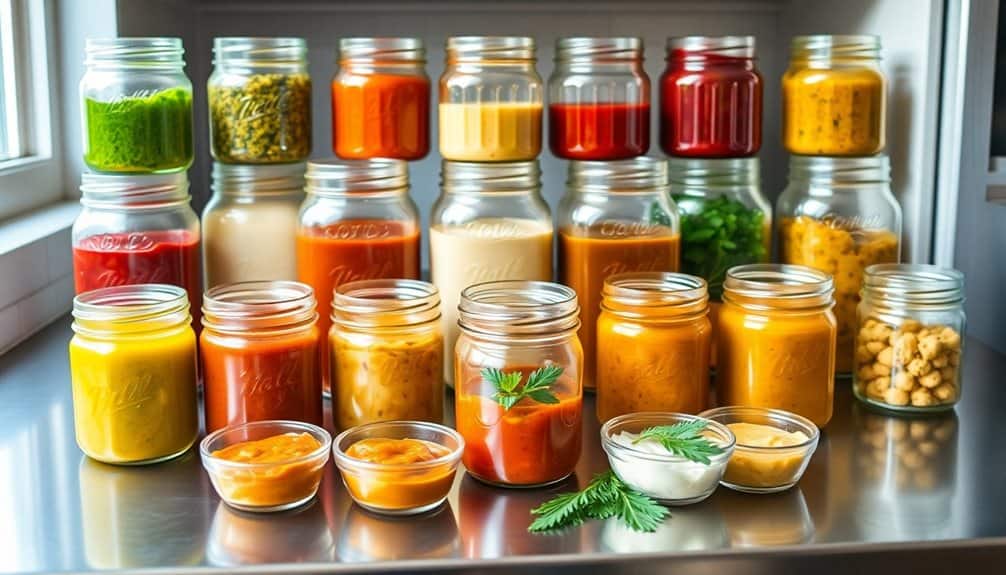
Homemade sauces form the backbone of efficient meal prep, saving you both time and money while enhancing your dishes’ nutritional value. You’ll want to prepare versatile sauces that complement multiple proteins and vegetables, maximizing their utility throughout the week. Basic tomato sauce, herb-infused pesto, and nutrient-rich tahini dressing can transform basic ingredients into diverse meals.
Store your make-ahead sauces in airtight containers for 5-7 days in the refrigerator, or freeze them in ice cube trays for up to three months. A basic vinaigrette combines 3 parts oil with 1 part acid (vinegar or citrus), plus herbs and seasonings. You’ll get ideal nutrition by including healthy fats like olive oil, which aids in vitamin absorption.
For a protein-rich sauce, blend Greek yogurt with herbs, garlic, and lemon juice – it’s rich in probiotics and calcium. Create an antioxidant-packed peanut sauce using natural peanut butter, ginger, low-sodium soy sauce, and lime juice. These combinations provide essential nutrients while keeping sodium and added sugars in check. Remember to label your sauces with preparation dates and ingredients for efficient meal planning.
Seasoning Blends

Like sauces, seasoning blends serve as powerful flavor foundations in meal prep, but they offer unique advantages regarding storage and versatility. They’re shelf-stable, take up minimal space, and can transform basic ingredients into diverse cultural dishes. By creating your own blends, you’ll eliminate unnecessary additives while considerably reducing costs compared to pre-made options.
When designing your seasoning combinations, focus on balancing flavor profiles while maximizing nutritional benefits. Many herbs and spices contain beneficial compounds like antioxidants, anti-inflammatory agents, and metabolism-boosting properties.
- Mediterranean Blend: oregano, basil, thyme, and rosemary provide polyphenols and essential oils
- Anti-inflammatory Mix: turmeric, black pepper, and ginger enhance bioavailability and reduce inflammation
- Metabolic Boost: cayenne, cinnamon, and cumin support healthy blood sugar and fat metabolism
- Antioxidant Blend: garlic powder, onion powder, and paprika deliver sulfur compounds and carotenoids
- Umami Enhancement: nutritional yeast, mushroom powder, and seaweed flakes add B-vitamins and minerals
Store your blends in airtight containers away from heat and light to preserve their potency for up to six months. Label each blend with ingredients and creation date for ideal tracking.
Meal Rotation Tips

Strategic meal rotation prevents food fatigue while maximizing nutritional variety and cost efficiency in your weekly meal prep. You’ll want to establish a 3-4 week rotation schedule, ensuring you’re not eating the same meals too frequently. This approach helps maintain micronutrient diversity while keeping your grocery budget predictable.
Create your rotation by categorizing meals into protein types: lean meats, fatty fish, plant-based proteins, and eggs. Aim to include at least two servings of fatty fish weekly for essential omega-3s, and alternate between different plant proteins to obtain various amino acid profiles. You’ll also want to rotate your grain bases between brown rice, quinoa, and whole wheat options.
Consider seasonal produce availability when planning your rotation. Summer vegetables typically cost less during peak season, while root vegetables offer better value in winter months. You can maintain variety by switching preparation methods – roasting vegetables one week, stir-frying the next. Store rotation-specific recipes in a digital spreadsheet or app, including ingredient quantities and costs. Track which meals freeze well, allowing you to double-batch during prep sessions without compromising food quality.
Leftover Management

Through proper leftover management, you’ll maximize your meal prep investment while minimizing food waste and maintaining nutritional quality. Store prepared meals in airtight containers within two hours of cooking to prevent bacterial growth, and maintain refrigerator temperature at or below 40°F (4°C). Most prepped meals remain safe to eat for 3-4 days when properly refrigerated.
For ideal food safety and quality retention, follow these essential guidelines:
- Label containers with preparation dates and contents to track freshness and maintain organized rotation
- Store raw proteins on the bottom shelf to prevent cross-contamination through dripping
- Use glass containers when possible, as they don’t retain odors or stains and are microwave-safe
- Portion meals individually before storing to prevent repeated temperature fluctuations
- Keep herbs and greens separate until serving, storing them with a paper towel to absorb excess moisture
If you won’t consume prepped meals within four days, freeze them immediately. Most frozen meals maintain quality for 2-3 months when stored at 0°F (-18°C). Thaw frozen meals in the refrigerator overnight, never at room temperature, to guarantee food safety.
Quick Thawing Techniques

Safe thawing methods guarantee your prepped meals maintain their taste, texture, and nutritional value while preventing foodborne illness. When you’re working with frozen meal prep portions, you’ve got three reliable thawing options that meet food safety standards.
Your refrigerator method is the safest approach – transfer frozen containers to your fridge 24-48 hours before use. You’ll want to place them on the bottom shelf to prevent cross-contamination from potential drips. For faster results, you can use the cold water method: submerge sealed containers in cold tap water, changing it every 30 minutes. This technique thaws food at a rate of about 1-2 pounds per hour.
If you’re really pressed for time, your microwave’s defrost setting works for immediate cooking needs. Remove food from plastic containers and transfer to microwave-safe dishes. Rotate and flip items frequently to guarantee even thawing. Remember, you’ll need to cook microwave-thawed foods immediately, as some portions may begin cooking during the process. Never thaw frozen meals on your counter at room temperature – this puts food in the dangerous 40-140°F zone where bacteria multiply rapidly.
Reheating Best Practices

Proper reheating techniques preserve both the safety and quality of your prepped meals while maintaining their nutritional value. When you’re reheating meals, confirm the internal temperature reaches 165°F (74°C) to eliminate potential bacteria growth. Different foods require specific reheating methods to maintain their texture and flavor.
- Use a microwave-safe cover to trap steam and prevent food from drying out, stirring halfway through for even heating
- Heat rice with a tablespoon of water to restore moisture and prevent a rubbery texture
- Reheat proteins in the oven at 350°F for 15-20 minutes to maintain texture and prevent overcooking
- Steam vegetables briefly rather than microwaving to preserve nutrients and prevent mushiness
- Use a skillet to reheat stir-fries and noodle dishes, adding a small amount of oil to restore their original texture
Don’t reheat food more than once, as this increases the risk of foodborne illness and degrades nutritional quality. Store your prepped meals in shallow containers to confirm quick, even reheating. If you’re using glass containers, let them come to room temperature before reheating to prevent thermal shock and potential breakage.
Frequently Asked Questions
Can I Meal Prep if I Have Dietary Restrictions or Food Allergies?
Yes, you can safely meal prep with dietary restrictions or food allergies. You’ll need to carefully plan your ingredients, read labels thoroughly, and avoid cross-contamination during preparation. Consider batch-cooking allergen-free proteins, grains, and vegetables separately. Many common allergens like dairy, nuts, or gluten have suitable alternatives that work well in meal prep. Always sanitize your workspace and use dedicated cooking tools for allergen-free foods.
How Do I Prevent Food Fatigue When Eating the Same Meals?
You can prevent food fatigue by incorporating variety within your meal prep routine. Try rotating different proteins, grains, and vegetables weekly, experimenting with diverse seasonings and spices, or using the same ingredients in different preparations. Adding various textures through raw vegetables, nuts, or seeds helps maintain interest. Consider batch-cooking base ingredients that you can mix and match with different sauces, dressings, or toppings throughout the week.
What Exercises Pair Best With These Meal-Prepped Portions for Weight Loss?
Time is muscle when it comes to exercise and nutrition working together. You’ll get ideal results by combining your portioned meals with a mix of strength training and cardio. Focus on compound exercises like squats, deadlifts, and push-ups three times weekly, and add 30 minutes of moderate cardio on alternate days. This combination helps create a caloric deficit while preserving lean muscle mass for sustainable weight loss.
Should I Meal Prep Differently During Summer Versus Winter Months?
You’ll want to adjust your meal prep seasonally to take advantage of fresh produce and match your body’s changing needs. In summer, focus on hydrating foods, lighter meals, and raw preparations that don’t heat up your kitchen. Include more berries, melons, cucumbers, and leafy greens. During winter, opt for heartier, warming foods like roasted root vegetables, soups, and stews that provide sustained energy and comfort.
Can My Kids Help With Meal Prep, and at What Age?
Kids can definitely develop delightful dining skills through meal prep, starting as young as age 2. You’ll want to match tasks with their developmental abilities: toddlers can wash produce and mix ingredients, 5-7 year-olds can measure and spread, while 8-12 year-olds can handle basic knife skills with supervision. Cooking teaches math, science, and nutrition while building confidence. Plus, children who help prepare meals are more likely to eat healthier foods.


